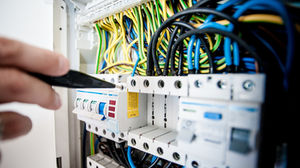Switchboard - The basics when inspecting
- Corsence
- Feb 14, 2017
- 3 min read

What should I be looking for? and how should I inspect?
Before the two questions above can be answered we must determine what type of Switchboard is being inspected. Generally, within a building four common types of switchboard exist determined by their positions within the electrical system, these are:
Main Switchboard: The initial supply and distribution of the electricity for the building. In many cases the buildings most important electrical asset.
Generator Switchboard: Installed to distribute the secondary supply provided by the buildings diesel generators in the event of primary power loss.
Mechanical Switchboard: Supplies the buildings mechanical loads such as AC (chillers, condenser pumps etc.).
Distribution Board: Supplies sub circuits from the main switchboard acting as point of distribution within the field. Distribution boards usually supply the final sub circuits such as light and power.
Distribution Board: Located in the field and acts as a intermediate point of supply between the main switchboard and final sub circuits such as light and power.
NOTE: You could probably add a fifth switchboard to this list, Tenant Meter panel / distribution board, but for this article we will only look at a buildings main sources of electrical distribution.
What To Inspect
We believe that when inspecting a switchboard, the key areas and items that the inspection should be based around are:
Current condition of the asset itself
Compliance to standards and regulations
Electrical safety hazards
Fire mitigation
Labelling
Hazardous materials
Evidence of preventative maintenance
Where and how did we determine the above items? We have successfully completed over 1000 switchboard inspections and audits varying from main switchboards to house lighting distribution boards. Throughout these inspections, we developed and refined our very own checklists, as well as reference manuals to consult when inspecting each asset.
Main Switchboard & Generator Switchboard:

This checklist consists of 33 non-compliance items, focusing on compliance to relevant legislation standards and 5 further items focused on relevant hazards and general recommendations. Our reference manuals provide descriptions, non-compliance items, standard references and relevant recommendations for each item on the checklist.
Key Checklist Items Include:
Emergency Egress
Internal and External Cabling
Busbar Condition
Switchgear Condition
Labelling
Electrical hazards, hazardous material present
Correct Earthing configuration
To download a free copy of the checklist or to download the reference manual visit www.corsence.com or CLICK HERE.
Mechanical Switchboard & Distribution Board:

This checklist consists of 20 non-compliance items, focusing on compliance to relevant legislation standards and 5 further items focused on relevant hazards and general recommendations. Again our reference manuals provide descriptions, non-compliance items, standard references and relevant recommendations for each item on the checklist.
Key Checklist Items Include:
Residual current device installation
Enclosure condition
Circuit breaker schedule
Switchgear condition
Thermal/Infrared scan completed
To download a free copy of the checklist or to download the reference manual visit www.corsence.com or CLICK HERE.
The Inspection
You may have noticed that our inspection checklists contain no physical testing and is based around thorough visual inspections, why? When inspecting a switchboard, in most cases it is going to be energised! Therefore, certain safety precautions need to be considered.
We recommend that for a proper visual inspection and assessment to be carried out, the cover(s) of the switchboard must be taken off (if deemed safe to do so), therefore this should only be carried out only by a licensed electrician. Without removing the cover, you only gain a brief overview of the current condition of the associated switchboard.
For more information on the required equipment and procedures, including tips on safely removing the cover when inspecting a live switchboard, check out an earlier article we posted “Inspecting Electrical Panel”.
We hope this post was informative and encourage questions, feedback and further tips in the comments section.














